MTX Audio Thunder 4405 User Manual
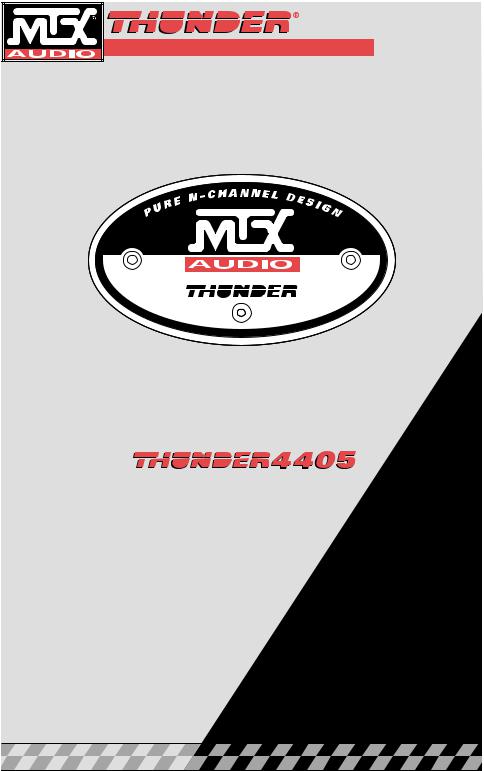
AMPLIFIER OWNER’S MANUAL
5-CHANNEL POWER AMPLIFIER
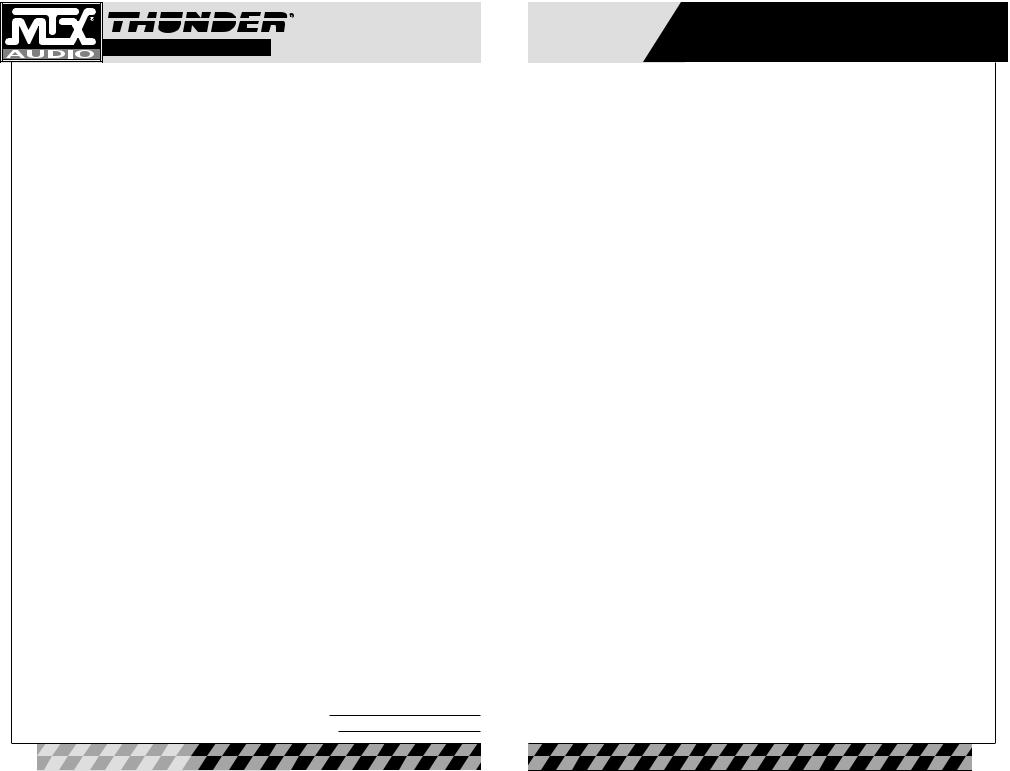
AMPLIFIERS
Introduction
CONGRATULATIONS...
ENGLISH |
on your purchase of a new MTX Audio |
|
|
|
Thunder Amplifier! MTX has long been |
|
the industry leader in mobile enclosures |
|
and speakers, and we have reached |
|
new heights with the development of the |
|
new MTX Thunder amplifiers. You |
|
couldn’t have chosen a more reliable, |
|
powerful, or better performing amplifier. |
|
In fact, we back up every Thunder |
|
amplifier with a three-year warranty if |
|
installed by an authorized MTX Audio |
|
retailer (see the warranty statement). |
Your new MTX Thunder amplifier was designed, built and thoroughly tested at our state-of-the-art electronics manufacturing facility in Phoenix, Arizona. We manufacture every amplifier using the latest Intelligent Surface Mount Technology. Some of the advantages of the new design are its significant improvements to the amplifier’s electrical and mechanical properties. ISMT devices feature substantially shorter internal and external lead lengths. This reduces stray capacitance and inductance, which results in cleaner and more accurate musical reproduction with significantly less noise interference. The ISMT mounter produces amplifier boards with smaller and lighter components, which are more resistant to vibrations inherent in the automotive environment.
A word about power ratings. It is important for you to know how they stack up. MTX has chosen the most honest, most conservative way to rate our amps. We show you the RMS power, at 12.5 volts, and dynamic power at 14.4 volts. However, we go above and beyond the call of duty. We test each amplifier. The technician records the “actual” power output, and records this number on your Certified Performance Certificate. The amplifier
must meet or exceed the rated specification before we’ll ship it. No questions. No exceptions.
We want to ensure you get continuous high performance from your MTX Thunder amplifier, so we recommend that you have it professionally installed by your authorized MTX dealer.
HOW TO USE THIS MANUAL
If you are installing this amplifier yourself, we recommend that you read the manual cover- to-cover before you install it. Familiarize yourself with the features and details on the input and output panels. Make sure you have all the equipment you need. Then follow the step-by-step installation instructions included. Sample installation diagrams may be found on our website:
mtx.com
If you have any questions, write or call us: MTX Audio
4545 E. Baseline Rd. Phoenix, AZ 85042
602-438-4545 • 800-CALL MTX technical@mtx.com mtx.com
Please take a moment to register your purchase on line at mtx.com.
Please also record the serial number of your amplifier in the space provided below and keep this manual for future reference, as well as your sales receipt as proof of ownership. (The serial number of your amplifier is marked on the bottom of its metal chassis.)
Serial Number: Date of Purchase:
Features
•Intelligent Surface Mount Technology
•Patented PWM MOSFET Switching Power Supply (#5,598,325)
•Class A 100% Discrete Driver Circuit Topology
•Class A/B, Amplifier (front and rear)
•Dedicated AdaptiveClass D Sub Channel
•High Powered Transformer
•Pure N-Channel Design (front and rear)
•Doubles power into 2 ohms
•Bridgeable, multi-channel circuit design
•Real Time Computerized Protection Circuit
•18dB/Octave, defeatable/fixed 85Hz HP filter (front and rear)
•18dB/Octave, butterworth fixed 85Hz LP filter x 1 (subwoofer)
•Continuously adjustable and defeatable Bass EQ enhancement circuitry, centered at 40Hz - subwoofer channel only
•Low level inputs
•External Bass Control Port for easy Bass Adjustment via optional EBC unit (subwoofer)
•Front, rear and subwoofer individually adjustable input sensitivity
•Input select allows all channels to be driven using either 2,4 or 5 inputs
•Nickel-plated, heavy duty terminal block type connectors
•2" max height for ease of installation
•Unique rubber Insulated Iso-Feet™ (#5,521,792)
•Bold and Aggressive Heatsink Shape and Size
Specifications
THUNDER4405
RMS Power measured at 12.5 Volts DC:
25 Watts RMS/Ch x 4 into 4 Ohms with less than 1% Thd+N 50 Watts RMS/Ch x 4 into 2 Ohms with less than 1% Thd+N
100 Watts RMS bridged x 2 into 4 Ohms with less than 1% Thd+N
Subwoofer
100 Watts RMS into 4 Ohms with less than 1% Thd+N 200 Watts RMS into 2 Ohms with less than 1% Thd+N
Dynamic Power measured at 14.4 Volts DC Front and Rear
65 Watts x 4 into a 4 Ohm load
125 Watts x 4 into a 2 Ohm load
250 Watts bridged x 2 into a 4 Ohm load
Subwoofer
150 Watts x 1 into a 4 Ohm load
300 Watts x 1 into a 2 Ohm load
Signal to Noise Ratio: ≥ 100dB A-Weighted (front and rear) Signal to Noise Ratio: ≥ 90dB A-Weighted (subwoofer) Damping Factor: >200
Frequency Response: 20Hz-20kHz±0.25dB (front and rear) 20Hz - 85Hz (subwoofer)
Bass EQ: Variable Bass Boost (0-18dB) centered at 40Hz (subwoofer) Crossover: Fixed 85Hz, 18dB/Octave, HP Defeatable (front and rear)
Fixed 85Hz, 18dB/Octave, LP (subwoofer)
Dimensions:
13.2" x 9.75" x 2" (33.5cm x 24.8cm x 5.1cm)
15.5" x 9.75" x 2.1" (39.5cm x 24.8cm x 5.3cm) Including IsoFeet™
 2
2
3
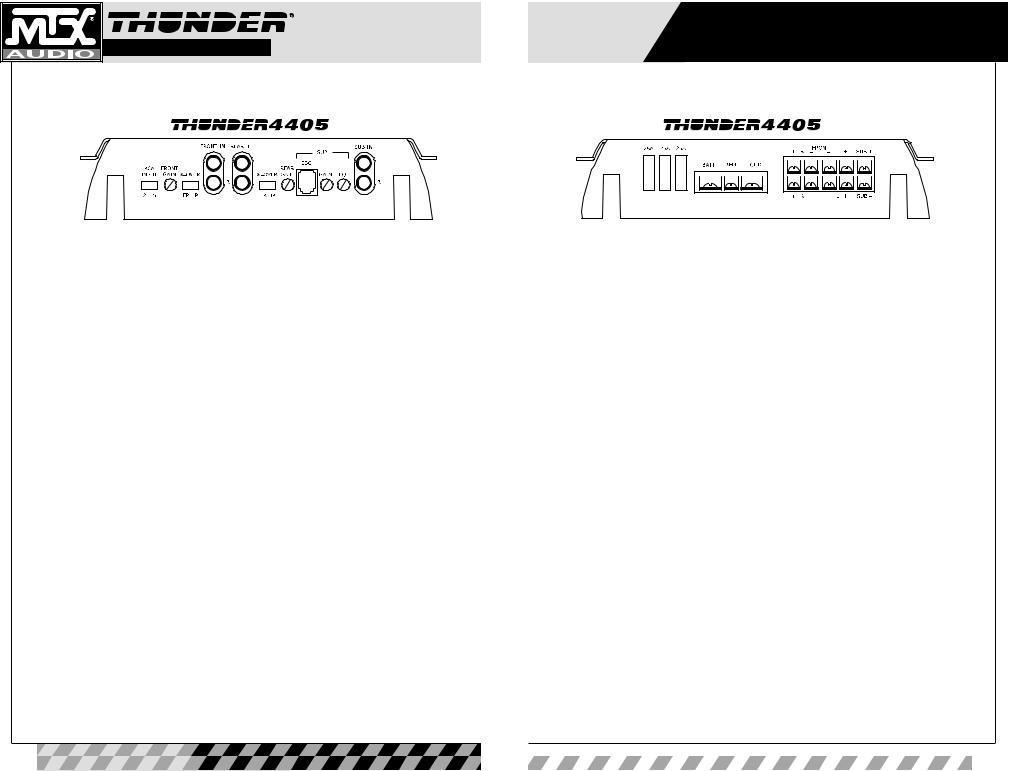
AMPLIFIERS
Input Panel Layout Output Panel Layout
1.Input Select 2CH / 4CH / 5CH – This switch, found on the Thunder4405, is used to match the amplifier’s input to the source unit’s output so all five channels of the amplifier are driven. If your source unit has 2 outputs (a left and right) connect them to the amplifier’s front channel inputs, and place the input select switch in the 2CH position. If your source unit has 4 outputs, (left front, left rear, and right front, right rear) connect them to the amplifier inputs and place the input select switch in the 4CH postion. In the 4CH position, the fader on your source unit will operate. If your source unit has 5 or 6 outputs, (left front, left rear, right front, right rear and subwoofer) connect them to the amplifier inputs and place the input select switch in the 5CH postion.
2.Gain Control – These controls are used to match the input sensitivity of the amplifier position to the particular source unit that you are using. The controls are factory set to 1Vrms.
3.Crossover Control Front and Rear – This switch turns the internal electronic high pass 18dB/Octave 85Hz crossovers on and off. If the switch is selecting HP, the crossover is on. When the switch is selects FR, the crossover is bypassed for a full range output. (Subwoofer is a fixed low pass 18dB/Octave 85Hz crossover)
4.RCA Input Jacks Front and Rear – RCA or type input jacks for use with source units that have RCA or Line Level Outputs. A source unit with a minimum output level of 200mV is required for proper operation.
5.Bass EQ – This equalization circuit is used to enhance the low frequency response of the vehicle’s interior. With up to 18 dB of boost and centered at 40Hz, the Bass EQ can be adjusted to meet your own personal taste.
6.RCA Input Jacks (Sub) – L + R inputs are supplied to simplify installation. The left and right inputs sum internally to form a single monaural channel. The left and right inputs are electronically isolated and will not affect the isolation of the other four channels. A source unit with a minimum output level of 200mV is required for proper operation.
7.EBC – The EBC, or Electronic Bass Control, allows a remote bass control to be adjusted from the driver’s seat. If the optional EBC is installed, the bass level will be able to be adjusted to overcome noise and other interference.




1.Fuses – For convenience, all amplifiers utilize ATC type fuses. For continued protection in the event that a fuse blows, replace the fuse only with the same value.
Caution: The power fuses on the amp are for protecting the amp against overdrive. To protect the vehicle’s electrical system, an additional fuse is required within 18" of the battery on the 12V+ cable.
2.Power Terminal – This is the main power input for the amplifier and must be connected directly to the positive terminal of the car battery for the amplifier to operate properly. See the chart below for recommended cable sizes for each amplifier. Use caution when running this cable through the car. Try to avoid the input RCA cables, antenna cabling, or other sensitive equipment as the large amount of current flowing through this cable can induce noise into your system. It is also very important to have a tight connection to ensure maximum performance.
3.Ground Terminal – A good quality ground is required for your Thunder Amplifier to operate at peak performance. A short length of cable the same gauge as your power cable should be used to attach the ground terminal directly to the chassis of the car. Always scrape or sand any painted surfaces to expose bare metal where the ground wire will attach.
4.Remote Terminal – All Thunder Amplifiers can be turned on by applying 12 volts to this terminal. Typically this voltage is supplied by a wire from the source unit marked “remote” or “electric antenna”.
5.Term Block Right Channel – The Right Rear + and Right Rear – terminals connect the right rear speaker to the right rear channel of the amplifier. Connect the + terminal of the speaker to the Right Rear + terminal of the amplifier and the – terminal of the speaker to the Right Rear – terminal of the amplifier. 2 ohm minimum impedance is allowed. Operation the same for front channels.
6.Term Block Left Channel – The Left Rear + and Left Rear – terminals connect the left rear speaker to the left rear channel of the amplifier. Connect the + terminal of the speaker to the left Rear + terminal of the amplifier and the – terminal of the speaker to the left Rear – terminal of the amplifier. 2 ohm minimum impedance is allowed. Operation the same for front channels.
7.Term Block Sub Channel – The sub + and sub - terminals connect the subwoofer to the dedicated subwoofer channel of the amplifier. Connect the + terminal of the speaker to the sub + terminal of the amplifier and the – terminal of the speaker to the sub – terminal of the amplifier. 2 ohm minimum impedance is allowed.
8.Speaker Terminals – As shown in the wiring diagrams, be sure to observe speaker polarity through the system. Failing to wire the speakers in proper phase could result in a loss of bass response and/or poor overall sound quality. Caution: Thunder amplifiers are not recommended for loads below 2 ohms stereo or
4ohms bridged.
 4
4














 5
5
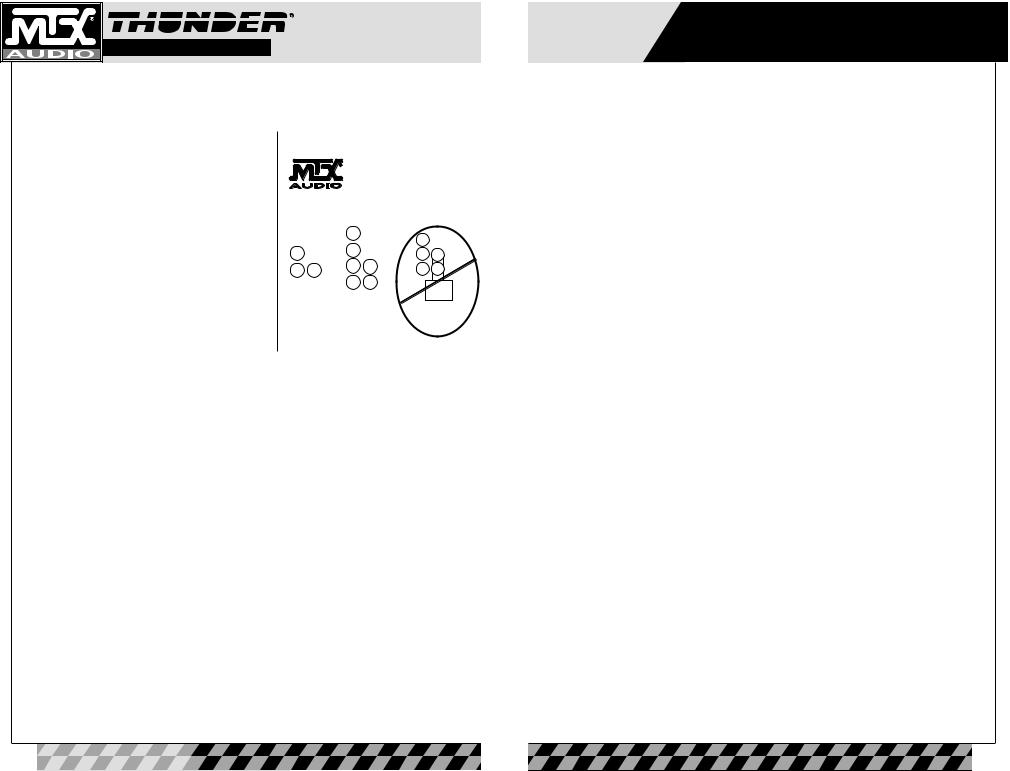
AMPLIFIERS
Adjusting the Gain
1.Turn the gain controls on the amplifier all the way down.
2.Turn up the volume control on the source unit to approximately 3/4 of maximum.
3.Adjust the front channel gain control on the amplifier until audible distortion occurs.
4.Adjust the front channel gain control down until audible distortion disappears.
5.Follow steps 3-4 for rear channel and sub-channel gain settings.
6.The amplifier is now calibrated to the source unit’s output. The rear and sub channels may be adjusted according to your personal taste.
Typical Speaker
Wiring
Configurations
5-Channel Amplifier
Mono Amp and Bridged Stereo Amp
Impedance Requirements
— 2 ohm minimum for sub (mono) channel
—4 ohm bridge minimum for stereo channels
—2 ohm stereo minimum for stereo channels
Note: The information shown for bridged stereo channels is good for both the front and rear channels
4 ohm |
|
|
||
4 ohm |
|
4 ohm |
|
|
|
|
|
|
|
|
+ + - - + |
|||
|
- |
L L R R |
||
|
||||
|
s |
|
|
|
|
u |
|
|
|
|
b |
|
|
|
|
|
|
|
|
Two 4 ohm speakers for sub channel
One 4 ohm speaker for bridged stereo channel
OK
8 ohm |
|
|
|
|
8 ohm |
|
|
|
|
8 ohm |
|
|
|
|
8 ohm |
|
|||
8 ohm |
|
8 ohm |
|
|
|
|
|
|
|
|
+ + - - + |
|||
|
- |
L L R R |
||
|
||||
|
|
s |
|
|
|
|
u |
|
|
|
|
b |
|
|
|
|
|
|
|
Four 8 ohm speakers for sub channel
Two 8 ohm speakers for bridged stereo channel
OK
4 ohm |
|
4 ohm |
4 ohm |
4 ohm |
4 ohm |
+ + - - +
- L L R R s
u b
Three or more 4 ohm speakers for sub channel
Two 4 ohm speakers for bridged stereo channel
NOT
OK
Definitions of Common Terms
The following list of terms with their definitions is offered as help in understanding the set-up and operation of your amplifier.
1.Crossover (xover) - an electrical filter with high-pass or low-pass characteristics that divides the frequency range into playable bands for certain speakers. Subwoofers, mid-bass, midrange and tweeters are all designed to play different frequencies and should do so to avoid damage. The xover point is where the playable frequencies cross from one speaker to the next at -3dB below reference level.
2.Full-range - refers to signals which cover the entire audio frequency span from 20Hz to 20kHz.
3.High-pass - simply put, this blocks lower frequencies which damage smaller speakers, and passes the higher frequencies for smaller speakers like the midrange and tweeter.
4.Low-pass - you got it, this is the inverse of a high-pass. It blocks higher frequencies and passes the playable lower frequencies to the larger speakers, like subwoofers.
5.Impedance - the resistance to the flow of current in an alternating current circuit (such as with music). Line level circuits are typically a high impedance of several thousand ohms, while speaker level circuits are usually a low impedance of a few ohms.
6.Line level - the type of signal produced at the outputs of tape decks, CD tuners, preamplifiers, etc., with a typical value of a volt or less in a high impedance circuit.
7.Speaker level - the type of output that is meant to drive speakers. These signals are sometimes called high level and are usually connected by two conductor speaker wires.
8.Signal - the signal of an audio system is what is heard from the speakers. These signals may be high pass, low pass or full-range.
We don’t have enough space for Electronics 101, so if you have a good, bad or amusing question, please call us TOLL FREE at 800-CALL MTX! (800-225-5689)
Troubleshooting
Read this if you wanna be a do-it-yourselfer – or give us a call at 800-CALL MTX.
Problem |
Cause |
Solution |
No LED indication |
No +12V at remote connection |
Supply +12V to terminal |
|
No +12V at Power connection |
Supply +12V to terminal |
|
Insufficient ground connection |
Verify ground connection |
|
Blown power fuse |
Replace fuse |
LED on, no output |
Volume on head unit off |
Increase volume on head unit |
|
Speaker connections not made |
Make speaker connections |
|
Signal processing units off |
Apply power to signal processor |
|
All speakers blown |
Replace speakers |
Output distorted |
Head unit volume set too high |
Lower head unit volume |
|
Amplifier gain set too high |
Lower amplifier gain |
Balance reversed |
Speakers wired L + R reversed |
Wire speakers with correct orientation |
|
RCA inputs reversed |
Reverse RCA inputs |
Some balance reversed |
Some Speakers wired L + R |
Wire speakers with correct orientation |
|
reversed |
|
|
Some RCA inputs reversed |
Reverse appropriate RCA inputs |
Bass is boomy |
Thunder EQ too high |
Lower setting |
Bass is weak |
Thunder EQ too low |
Raise setting |
|
Speakers wired out |
Wire with correct phase |
|
of phase |
|
|
Not using MTX woofers |
Buy MTX woofers |
Blowing fuses |
Excessive output levels |
Lower volume |
|
Amplifier defective |
Return for service |
 6
6
7
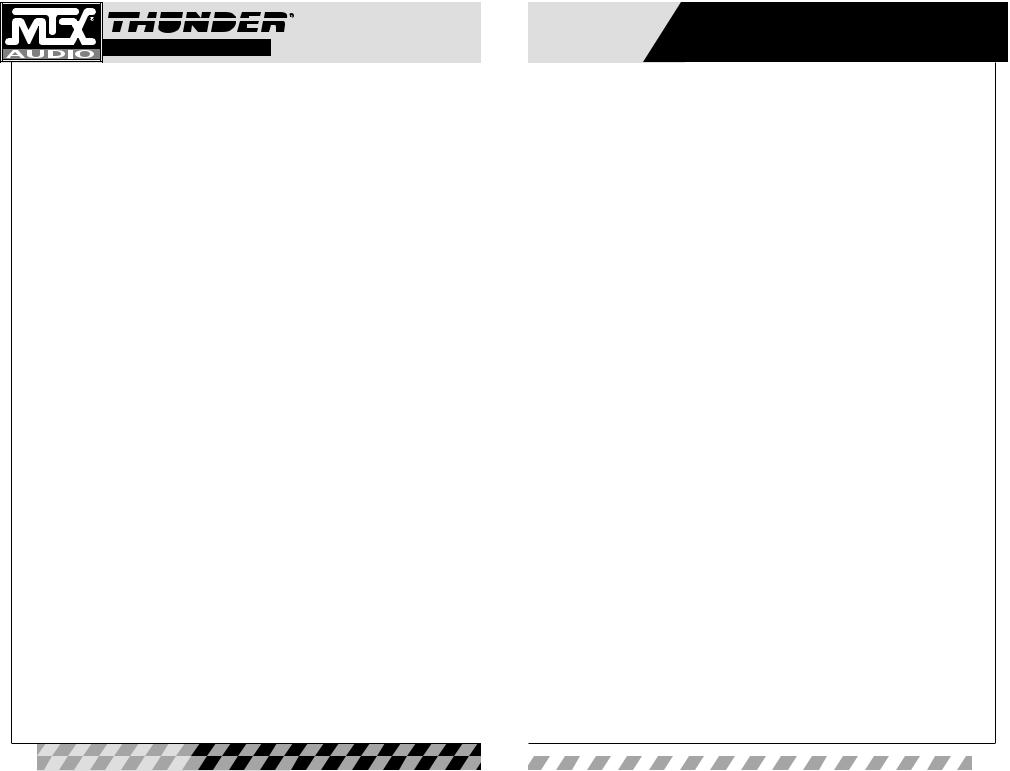
AMPLIFIERS
Introduction
|
FELICITATIONS... |
|
FRANÇAIS |
vous félicitant de votre achat d’un nou- |
|
pendant trois ans chaque amplificateur |
||
|
veau amplificateur MTX Audio Thunder ! |
|
|
MTX a été depuis longtemps un leader |
|
|
dans l’industrie d’enclos mobiles et |
|
|
speakers, et nous sommes arrivés à un |
|
|
nouveau sommet avec le développement |
|
|
des nouveaux |
amplificateurs MTX |
|
Thunder. Vous n’auriez pas pu choisir |
|
|
d’amplificateur plus fiable, plus puissant |
|
|
ou meilleur - en effet ; nous garantissons |
|
Thunder s’il est installé par un vendeur agréé (voir la garantie).
Votre nouvel amplicateur MTX Thunder a été conçu, construit et testé dans notre usine électronique de dernier cri à Phoenix, Arizona. Nous fabriquons chaque amplificateur en employant la Technologie Surface Mount le plus récent et intelligent . Quelques advantages du nouveau dessin sont les perfectionnements aux propriétés mécaniques et électriques de l’amplificateur. Les mécanismes SMT ont de substantiellement plus courtes longueurs internes et externes. Cela réduit l’inductance et la capacitance égarées, qui résulte en une reproduction musicale plus pure et plus exacte avec considérablement moins d’intervention du bruit. Le SMT mounter produit des cartes d’amplificateur avec plus petits et plus légèrs composants qui sont plus résistants aux vibrations inhérentes dans l’environnement automobile.
Un mot au sujet d’évaluations de puissance. C’est important de savoir comment elles s’y comparent. MTX a choisi la méthode la plus honnête et la plus conservatrice d’estimer les ampères. Nous vous montrons la puissance RMS, aux 12,5 volts et la puissance dynamique aux 14,4 volts. Cependant ; nous allons au-delà l’appel de devoir. Nous testons chaque amplificateur. Le technicien enregistre la puissance
de sortie ‘actuelle’, et puis il note ce nombre sur votre Certificat de Performance Attesté. L’amplificateur doit satisfaire ou dépasser les spécifications d’évaluation avant d’être envoyé. Pas de questions. Pas d’exceptions.
Nous voulons tout faire pour assurer que vous obtenez la haute performance continue de votre amplificateur MTX Thunder, donc nous vous recommandons de l’avoir installé professionellement par votre vendeur agréé.
COMMENT UTILISER CE MANUEL
Si vous installez cet amplificateur vous-même, nous vous recommandons de lire ce manuel de la première à la dernière page avant de l’installer. Familiarisez-vous avec les caractéristiques et les détails des panneaux entrée-sor- tie. Vérifiez que vous avez tout l’équipement dont vous avez besoin. Puis suivez les instructions d’installation point par point qui se trouvent à la page 4. Vous pouvez trouver des échantillons des diagrammes d’installation sur le Web à notre site :
mtx.com
Si vous avez des questions, écrivez ou téléphonez-nous à :
MTX Audio
4545 E. Baseline Rd. Phoenix, AZ 85042 602-438-4545 800-CALL MTX technical@mtx.com mtx.com
Caractéristiques
•Technologie Intelligente Surface Mount
•Source d’alimentation à découpage PWM MOSFET brevetée (n° 5 598 325)
•Topologie de circuit à pilote 100 % discret, catégorie A
•Ampli x 4, classe A/B
•Sub-canal de classe D adaptation fixée
•Transformateur haute puissance
•Dessin N-Canal pur (avant et arrière)
•Double la puissance sous 2 ohms
•Circuit multicanal avec possibilitété d’écoute
•Circuit de protection informatisé temps réel
•18dB/Octave, défait, fixé 85 Hz HP filtre (avant et dos)
•18dB/Octave, butterworth fixé 85 Hz HP filtre x 1 (subwoofer)
•Circuit d’accentuation des basses Bass EQ, réglable en continu ou supprimable, centré sur 40 Hz canaux arrière et subwoofer
•Entrées de basse fréquence
•Prise de commande des bassesEBC-External pour une correction facile des basses via l’EBC (subwoofer) en option
•Sensibilité de tension avant, arrière et subwoofer réglable
•La sélection d’entrée permet de commander les canaux en utilisant les entrées 2,4 ou5
•Connecteurs nickelés, d’un type bloc terminal à usage industriel
•Hauteur maximale de 5 cm pour faciliter l’installation
•Iso-Feet™ uniques, isolants en caoutchouc (#5,521,792)
•Forme et dimensions osées et agressives d’un radiateur
Specifications
THUNDER4405
RMS Power measured at 12.5 Volts DC:
25 Watts RMS/Ch x 4 into 4 Ohms with less than 1% Thd+N 50 Watts RMS/Ch x 4 into 2 Ohms with less than 1% Thd+N
100 Watts RMS bridged x 2 into 4 Ohms with less than 1% Thd+N
Subwoofer
100 Watts RMS into 4 Ohms with less than 1% Thd+N 200 Watts RMS into 2 Ohms with less than 1% Thd+N
Dynamic Power measured at 14.4 Volts DC Front and Rear
65 Watts x 4 into a 4 Ohm load
125 Watts x 4 into a 2 Ohm load
250 Watts bridged x 2 into a 4 Ohm load
Subwoofer
150 Watts x 1 into a 4 Ohm load
300 Watts x 1 into a 2 Ohm load
Signal to Noise Ratio: ≥ 100dB A-Weighted (front and rear) Signal to Noise Ratio: ≥ 90dB A-Weighted (subwoofer) Damping Factor: >200
Frequency Response: 20Hz-20kHz±0.25dB (front and rear) 20Hz - 85Hz (subwoofer)
Bass EQ: Variable Bass Boost (0-18dB) centered at 40Hz (rear and subwoofer) Crossover: Fixed 85Hz, 18dB/Octave, HP Defeatable (front and rear)
Fixed 85Hz, 18dB/Octave, LP (subwoofer)
Dimensions:
13.2" x 9.75" x 2" (33.5cm x 24.8cm x 5.1cm)
15.5" x 9.75" x 2.1" (39.5cm x 24.8cm x 5.3cm) Including IsoFeet™
 8
8














 9
9
